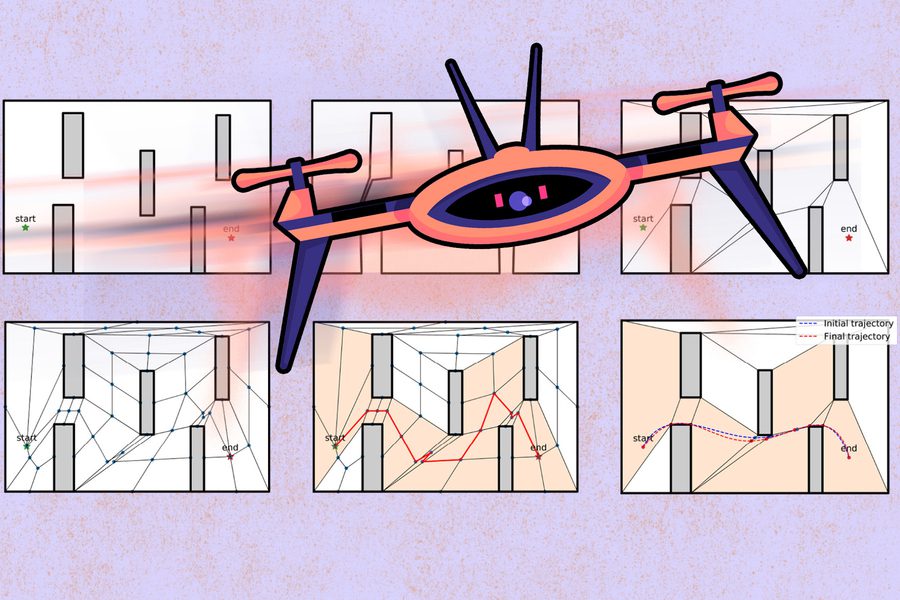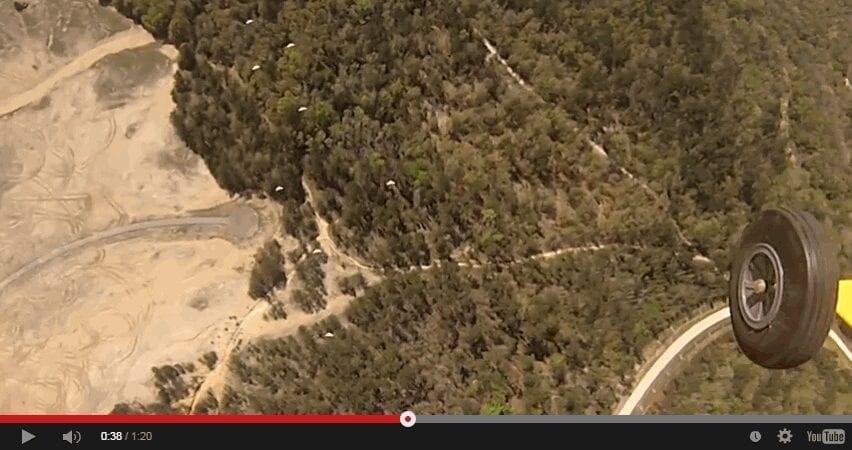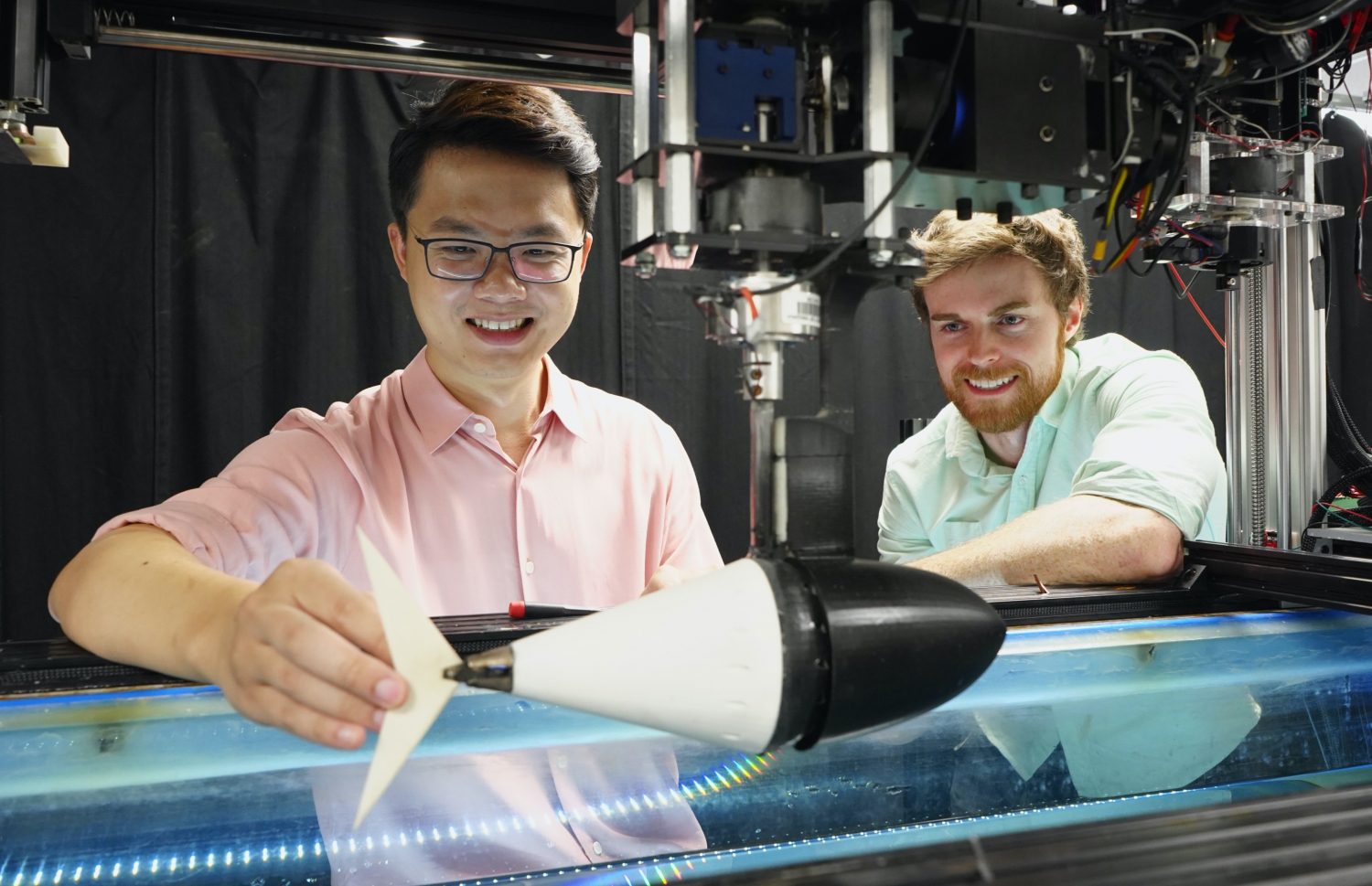
Aerospace engineers at MIT have devised an algorithm that helps drones find the fastest route around obstacles without crashing.
Image: MIT News with background figures courtesy of the researchers
New algorithm could enable fast, nimble drones for time-critical operations such as search and rescue
If you follow autonomous drone racing, you likely remember the crashes as much as the wins. In drone racing, teams compete to see which vehicle is better trained to fly fastest through an obstacle course. But the faster drones fly, the more unstable they become, and at high speeds their aerodynamics can be too complicated to predict. Crashes, therefore, are a common and often spectacular occurrence.
But if they can be pushed to be faster and more nimble, drones could be put to use in time-critical operations beyond the race course, for instance to search for survivors in a natural disaster.
Now, aerospace engineers at MIT have devised an algorithm that helps drones find the fastest route around obstacles without crashing. The new algorithm combines simulations of a drone flying through a virtual obstacle course with data from experiments of a real drone flying through the same course in a physical space.
The researchers found that a drone trained with their algorithm flew through a simple obstacle course up to 20 percent faster than a drone trained on conventional planning algorithms. Interestingly, the new algorithm didn’t always keep a drone ahead of its competitor throughout the course. In some cases, it chose to slow a drone down to handle a tricky curve, or save its energy in order to speed up and ultimately overtake its rival.
“At high speeds, there are intricate aerodynamics that are hard to simulate, so we use experiments in the real world to fill in those black holes to find, for instance, that it might be better to slow down first to be faster later,” says Ezra Tal, a graduate student in MIT’s Department of Aeronautics and Astronautics. “It’s this holistic approach we use to see how we can make a trajectory overall as fast as possible.”
“These kinds of algorithms are a very valuable step toward enabling future drones that can navigate complex environments very fast,” adds Sertac Karaman, associate professor of aeronautics and astronautics and director of the Laboratory for Information and Decision Systems at MIT. “We are really hoping to push the limits in a way that they can travel as fast as their physical limits will allow.”
Tal, Karaman, and MIT graduate student Gilhyun Ryou have published their results in the International Journal of Robotics Research.
Original Article: System trains drones to fly around obstacles at high speeds
More from: Massachusetts Institute of Technology
The Latest Updates from Bing News & Google News
Go deeper with Bing News on:
Flying drones
- Students go head to head in drone flying competition at Krammer Middle School
DOZENS OF JCPS STUDENTS REACHED NEW HEIGHTS THIS MORNING. STUDENTS FROM FIVE JCPS SCHOOLS CHECK IT OUT. THEY LEARNED HOW TO FLY DRONES AND THEN PARTICIPATED IN A DRONE FLYING COMPETITION. CAMARA ...
- Perrysburg Township to utilize drones in new emergency rescue tactics
Drone pilots must pass the FAA’s Part 107 exam in order to be certified to fly the small unmanned aircraft. Firefighter and paramedic Mike Thompson says the drones have re-written what's possible for ...
- Ontario prisons seeing more drone drops, with criminals often flying them right to inmates’ windows, guards’ union says
Criminals are constantly testing the limits of anti-drone measures inside prisons as Corrections Canada moves to tighten up its anti-drone security, Wilkins said. That includes sending fleets of ...
- U.S. loses third $30 million Reaper drone off Yemen's coast
The drones flying off the coast of Yemen are part of the U.S. military's efforts to help defend commercial and military ships against ongoing attacks by the Houthis.
- No. 1 threat: Drone attacks prompt urgent $500 million request from Pentagon
The proliferation of drones - seen as the new weapons system - has put pressure on the U.S military to boost its defense against these devices.
Go deeper with Google Headlines on:
Flying drones
[google_news title=”” keyword=”flying drones” num_posts=”5″ blurb_length=”0″ show_thumb=”left”]
Go deeper with Bing News on:
Faster drones
- Perrysburg Township to utilize drones in new emergency rescue tactics
Drone pilots must pass the FAA’s Part 107 exam in order to ... I mean- to be able to search and find someone a lot faster with that aerial image is huge," said Rodriguez. "To be able to have that tool ...
- No. 1 threat: Drone attacks prompt urgent $500 million request from Pentagon
The proliferation of drones - seen as the new weapons system - has put pressure on the U.S military to boost its defense against these devices.
- Walmart drones are hitting more areas
Walmart is ready to expand its drone delivery service to four stores in Texas.
- Red Bull's 217 Mph Drone Aims to Revolutionize Race Broadcasting
Motorsports can live and die by our ability to portray the live-action. Finally, we have a drone capable of showcasing MotoGP's ferocity.
- DJI Unveils Agras T50 and T25 Drones for Enhanced Agricultural Productivity
New Models Offer Advanced Features for Efficient Crop Management with Upgraded SmartFarm App DJI, a global leader in civilian drones and creative camera technology, today launched the Agras T50 and T2 ...
Go deeper with Google Headlines on:
Faster drones
[google_news title=”” keyword=”faster drones” num_posts=”5″ blurb_length=”0″ show_thumb=”left”]










